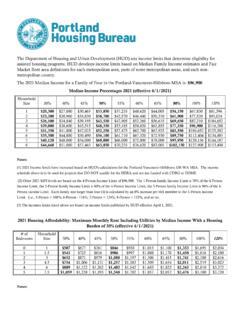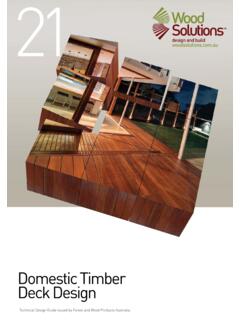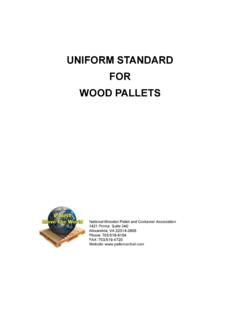Transcription of Deck Design Guide 3a - Portland, Oregon
1 deck Design Guide One and Two Family Residential Dwellings 3a The Bureau of Development Services (BDS) is providing this CONTENTS. information to help you Design your deck , obtain a building permit and pass inspections. The standards and details in this Guide will Do I Need A Permit?.. 2. help you determine how large the footings, beams, joists, posts, and What Plans Do I Need? .. 2. 1 900 SW 4th Avenue, Por tland, Oregon 97201 503-823-7300 w w CIT Y OF PORTLAND, Oregon - BUREAU OF DEVELOPMENT SERVICES. ledgers need to be; how to build lateral bracing, stairs, and railings;. and how to fasten all of the pieces together. This Guide does not General 3. take into account conditions which may affect your deck Design such as drainage conditions, slope conditions, or decks supporting loads Footings, Beams, Joists, and 4.
2 In excess of the standard uniform loads. Depending on your specific situation, you may need to hire a licensed architect or structural The Ledger 7. engineer prior to approval. Freestanding 11. You may include all, or part of the pre-approved Design standards and details in this Guide with your building permit plans for decks that are: Lateral Support of 11. For one- and two-family dwellings Framing 12. Single-span 13. All on one level 13. Not supporting a hot tub or spa 18. Not attached to house overhangs, bay windows, brick, stone or concrete block Chimneys/Bay 20. Not more than 10 feet above the ground deck Framing 21. Not bearing on ground with a slope greater than 2 feet horizontal Helpful 22. for every 1 foot vertical Guard Ledger board Rim joist Ledger board attachment Footing Grade Joist Post to beam connection Built-up beam deck Design Guide 1.
3 Introduction Do I Need A Permit For My deck ? A building permit is required for all decks that are more than 30 inches above the ground at any point. See Brochure 3 , Fences, Decks and Outdoor Projects. Setbacks and Other Regulations? For information on setbacks (how close a deck is to a property line) and other regulations that may apply to your deck project, even when a building permit is not required, see Brochure 3. Call Planning and Zoning at 503-823-7526 to find out what zoning requirements apply to your specific property. How Do I Get A Building Permit? See BDS handout, Brochure 1, Guide to Permits and Inspections. This handout describes the building permit process from application to final inspection. What Plans Do I Need? You may draw all your own plans and details without using this Guide , or you may use the pre-approved standards and details in this Guide to supplement your plans.
4 Refer to Brochure 6, What Plans Do I Need for a Building Permit? for descriptions and examples of the plans needed to obtain a building permit for a typical residential construction project. Since a deck can be a relatively simple project, you will only be required to provide the plans listed below if you use this Guide : Site Plan - You will need to draw a site plan. The Site Plan must show the property lines, outlines of all existing and proposed buildings, paved areas and decks on the lot, and the distances from your proposed deck to the nearest property lines. See Brochure 6 for Site Plan requirements and a sample Site Plan. Elevation View - You will also need to draw an Elevation View, which is a front or side view of your house and the proposed deck and the level of the ground adjacent to the deck (see Brochure 6).
5 Framing and Foundation Plan - You can draw your own Framing and Foundation Plans (see Brochure 6) or you can complete the Worksheet and Typical deck Plan at the end of this Guide . Cross Section and Details - You can draw your own Cross Section and Details (see Brochure 6) or you can use the details in this Guide . Your plans must include details of the following parts of your deck : Ledger board attachment Joist-to-beam connection Rim joist connection Post-to-beam connection Lateral support method Guardrail height and openings Guardrail post attachment Stair and stair handrail details Post-to-footing connection 2 deck Design Guide . General Notes 1. All lumber shall be grade #2 Douglas-Fir, Hem-Fir, or better and shall be pressure treated (to resist insect and dry rot) in accordance with American Wood-Preservers' Association Standards (Category).
6 deck surface and trim material of redwood, cedar, or other wood with a natural resistance to decay does not require pressure treatment. The level of treatment depends on the use as follows: a. Decking material, railings, joists, and beams must be treated to a Category UC3B (or must be other wood with a natural resistance to decay). b. Posts and other woods located on, in, or in contact with the ground must be a Category UC4B. c. Any wood less than six inches above the ground or in contact with concrete must be a Category UC4A. The level of preservative treatment is noted on the tags on the ends of the wood members. Remember, any time you make a cut, treat the cut end of the wood with a paint-on preservative. Cut ends expose the inner untreated wood to potential moisture and insect damage.
7 Hardwood and plastic or composite decking products may be substituted for conventional wood decking, but installation and span lengths of the substituted material must be in strict conformance with the product listing and the manufacturer's installation instructions. Copies of the manufacturer's installation instructions must be submitted with the building permit application. 2. All nails shall be common or box galvanized. It is recommended that common nails be used. They have a thicker shank and are stronger than box nails. 3. New pressure treatment methods use chemicals that will prematurely corrode standard fasteners, hardware, and flashing when in contact with pressure treated lumber; and as a result, fastener and hardware requirements have changed. Note the following: a.
8 All screws and nails shall be hot-dipped galvanized or stainless steel. b. All hardware (bolts, nuts and washers, joist hangers, mechanical fasteners, holdowns, tie plates cast-in-place post anchors, etc.) shall be galvanized with oz/sf of zinc (G-185 coating) or shall be stainless steel. Look for products such as Zmax from Simpson Strong-Tie or Triple Zinc from USP. 4. All decking material shall be 2x4, 2x6, or five quarter (5/4 ) boards. Attach decking to each joist with two 10d nails or two #8 screws. Decking may be placed from an angle perpendicular to the joists to an angle of 45 degrees to the joists. Decking must have a span length such that each board bears on a minimum of two joists. 5. Headers over existing doors, windows or openings greater than six feet in width that are located below a deck that will be attached to the house must be checked to verify that those headers can support the additional load added by the deck .
9 6. The bottom of all footings for decks that are attached to a house are to be placed a minimum of 18 inches below the surface of the finished grade and must bear on firm, undisturbed native soil. The bottom of footings for free-standing decks may be at any depth on undisturbed native soil. Footings adjacent to the top of a retaining wall must be set back from the wall a distance equal to the height of the wall, or be extend below grade an amount equal to the height of the retaining wall. deck Design Guide 3. Footings, Beams, Joists, and Posts First, decide how long and wide you want your deck . (Note: The drawings in this Guide indicate square or rectangular configurations, however, decks can be any shape as long as the longest joist and beam spans are used to determine the beam, joist, and footing sizes.)
10 Your deck can have up to a two-foot maximum joist and/or beam overhang. See Figures 1, 2, and 3. Beams must be supported on each end by a post and cannot be supported with beam hangers off the house. Use Table 1 to find the minimum beam, joist and footing sizes. Joists are identified as A , beams as B , posts as C, . and footings as D. It is recommended that you first determine the joist span, and then note what beam and footing sizes you will need. Optional overhang The span of a joist is measured from the centerline of bearing at one end of the joist to the centerline of bearing at the other and does not include overhangs. Blocking Maximum joist span lengths are noted in Table 1. See Figures 1 and 2 for joist Beam "B" Joist "A". span types. Post "C". Footing "D". 2'-0" max.











